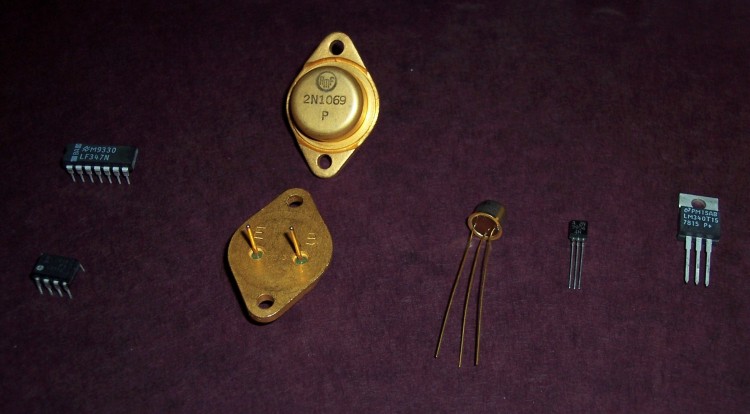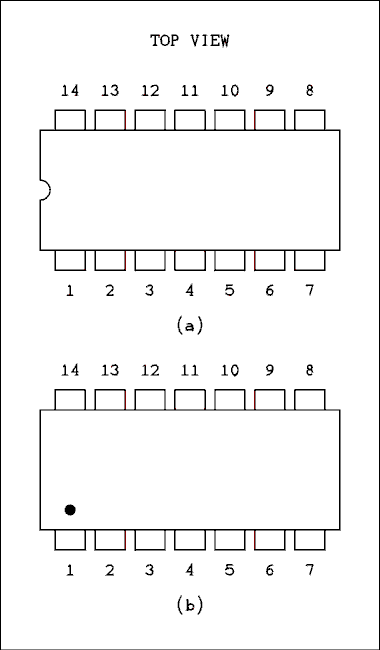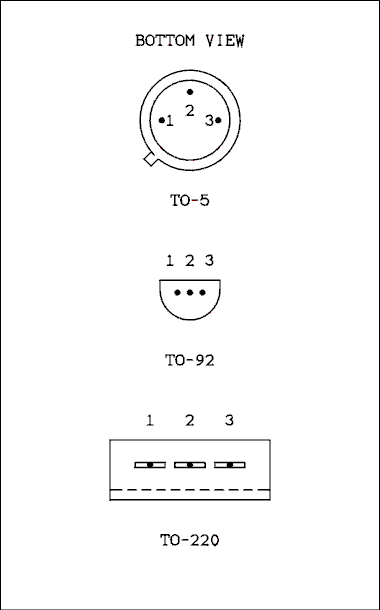
Appendix C.
Transistor and IC Packages.

If one is going to do laboratory experiments or do it yourself construction projects, one must know how pins on various ICs and transistors are designated. There are literally hundreds of packages and one is not likely to run into most of them. Only the most commonly found packages are covered here.On the left in the photo are an 8-pin and a 14-pin Dual Inline Package, DIP. The DIP comes in 6, 8, 14, 16, 18, 20, 24, 28, and 40-pin versions. The 24-pin and higher are twice the width of the smaller ones. Digital ICs, except for microprocessors, and analog devices, except for high input impedance amplifiers, come in DIPs. Military grade and wide temperature range industrial grade devices do not come in this plastic package.
Next is the TO-3 power package. Two are shown to reveal their appearance from top and bottom. Power transistors up to 200 watts and power ICs come in this style of package.
Next is the TO-5 package. Some of the best known early transistors, such as the 2N404 and 2N1302 came in this package. Premium quality ICs also come in the TO-5 configuration with 8, 10, or 12 pins, depending on the application.
Next is the ubiquitous TO-92 package. It is very inexpensive to manufacture and the low cost transistors in this package were, in part, responsible for the transistor boom of the 70s. 3-terminal voltage regulators are also sold in this package. They are limited to 3 pins.
Lastly is the almost as ubiquitous TO-220. Power transistors up to 50 watts and IC voltage regulators come in this package. It is sometimes seen with 4 or 5 pins.
The DIP.
IC data books give pin numbers and the user of such circuits must know where to start and which way around to number the pins. The figure below shows the pin numbering convention for the DIP.

There are two types of packages. Part a shows the most common which has a small notch cut in the end between pins 1 and the highest numbered pin. The pins are counted counter clockwise as viewed from the TOP.Part b shows a package used by Motorola. Pin 1 is marked with a dot and the pins are numbered counter clockwise as viewed from the TOP.

While the IC packages shown above are viewed from the top, these are viewed from the bottom. Some of the most common configurations will be given below but the student or experimenter should always consult the data sheet, or a data book for the particular transistor being used.TO-3.
A drawing of the TO-3 package is not necessary. The photo clearly shows the letters E and B next to the pins. The metal case is the collector terminal.In the case of an IC voltage regulator, the LM-309K to be specific, the pin on the right is the input and the left pin is the output. Backward? I think so but I didn't design it. The case is the common or ground. Always check the data sheet before wiring the circuit.
TO-5.
For most transistors in TO-5 packages the configuration is,Always consult the data sheet for the particular transistor. The metal case may be connected to the base, the collector, or to none of the elements.1 - Emitter,
2 - Base,
3 - Collector.
TO-92
For most bipolar transistors such as the 2N3904 and 2N3906 the pin configuration is,For the very popular MPF102 field effect transistor the pin-out is,1 - Emitter,
2 - Base,
3 - Collector.
For the positive low power voltage regulators, such as the 78L12, the pinout is,1 - Drain,
2 - Source,
3 - Gate.
For the negative low power voltage regulators, such as the 79L12, the pinout is,1 - Output,
2 - Ground,
3 - Input.
Always consult the data sheet for the particular transistor or IC you are using.1 - Ground,
2 - Input,
3 - Output.
TO-220.
For a bipolar transistor the pinout is,For a positive voltage regulator such as the 7812 the pinout is,1 - Base,
2 - Collector,
3 - Emitter.
For a negative voltage regulator such as the 7912 the pinout is,1 - Input,
2 - Ground,
3 - Output.
Always consult the data sheet for the particular transistor or IC you are using.1 - Ground,
2 - Input,
3 - Output.
Back to Fun with Transistors.
Back to Fun with Tubes."
Back to Table of Contents.